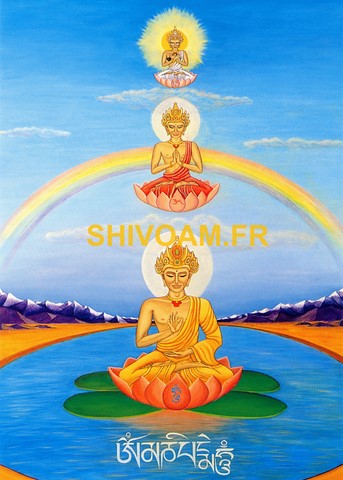Yoga's practice
.
The practice of yoga proceeds in the following way:
Yama (principles of a moral order, allowing one to be in harmony with one's fellow men, society, nature.)
1. Ahimsa – non-violence
2. Satya – telling the truth
3. Asteya – honesty
4. Brahmacharya – control of senses and sensuality
5. Aparigraha – non-possessiveness towards material things
Niyama: (self- discipline to progress in the path of yoga)
1. Saucha – purity
2. Santosha – contentment
3. Tapas – austerities, Yoga practice
4. Svadhyaya – study of the Self (one's true nature) and sacred scriptures
5. Ishwarapranidhana – surrender to what is higher
Asanas: poses
Pranayama: control of energy through breathing
Pratyara: abstraction of the senses
Dharana: concentration
Dyana (Chan in China, Zen in Japan): meditation
Samadhi: Contemplation
The last 3 categories are grouped under the name of Samyama (समाधि).
The first 2 principles (yama and niyama) are, unfortunately, rarely followed, especially in the West. However they are part of the essential basis to really progress in this science and this discipline
There are many kinds of traditional yoga and I will mention some of them:
Hatha yoga, Bhakti yoga, Karma yoga, Laya yoga, Kriya yoga, Nada yoga, Jnana yoga, Raja yoga, Ashtanga yoga, Yoga nidra, Dyana yoga etc...
In order not to mislead the reader, we speak here only Hatha yoga, Yoga nidra, Nada yoga and in Tibetan yoga, we advance tracks for the understanding and the practice of the 6 yogas of the 6 yogas of Naropa (see "Tibetan yoga and the secret techniques), mainly on the yoga of dreams and sleep, the yoga of the transfert of consciousness, the yoga of inner heat, the yoga of the intermediate state (bardo) (see "the Tibetan book of the dead), yoga of the clear light. (see "the awakening of the luminous mind")
Hatha yoga, Bhakti yoga, Karma yoga, Laya yoga, Kriya yoga, Nada yoga, Jnana yoga, Raja yoga, Ashtanga yoga, Yoga nidra, Dyana yoga etc...
In order not to mislead the reader, we speak here only Hatha yoga, Yoga nidra, Nada yoga and in Tibetan yoga, we advance tracks for the understanding and the practice of the 6 yogas of the 6 yogas of Naropa (see "Tibetan yoga and the secret techniques), mainly on the yoga of dreams and sleep, the yoga of the transfert of consciousness, the yoga of inner heat, the yoga of the intermediate state (bardo) (see "the Tibetan book of the dead), yoga of the clear light. (see "the awakening of the luminous mind")

It is necessary to specify that yoga is not a religious practice; it is a science of the spirit and the body, prodigious and complex, and especially a difficult practice for whoever wants to carry it out, and which, no more than physics or mathematics, requires to belong to any religion.
It improves the one who devotes himself to it with assiduity and interest, and one finds in France people belonging to the Christian religion who have drawn great benefits from it. For example, Jean Deschanet, or the monk Henri le Saux and also the priest Jules Monchanin. Yoga is also practiced in France in some monasteries or convents.
Being a science and a technique, it is secular and compatible with all religions.
.

Toolbox
Part of the practice of asana and pranayama is to be very attentive to the sensations in the body, during the posture and during the period of relaxation that follows; one thus becomes aware of the effect of the posture (or of the pranayama) and little by little, one begins to feel the energy body (pranic body).
We find, in several instructions concerning meditation, the development of this fine awareness of the sensations in the body and the interest of connecting to the energy body, which are an important aspect of this discipline.
However, the practice of asanas makes it easier to feel this perception; meditation will refine this through concentration linked to attention and this preliminary will promote this work.


